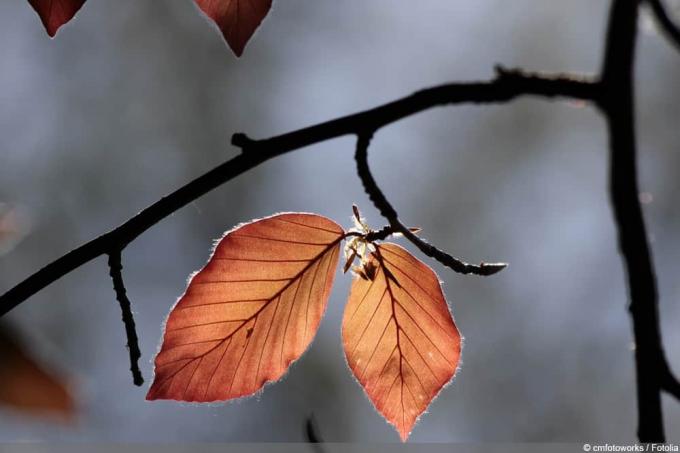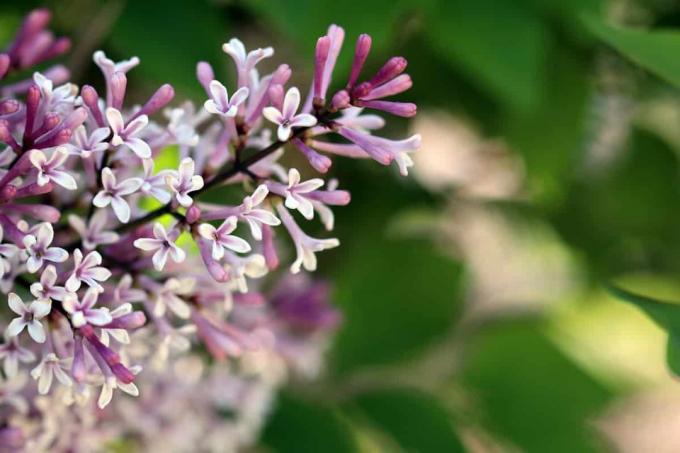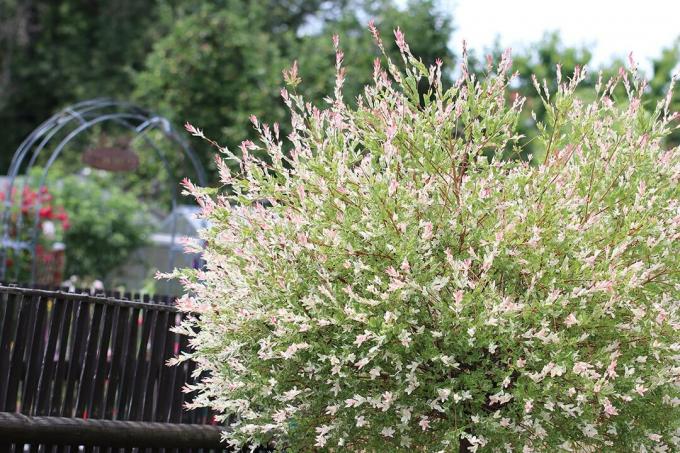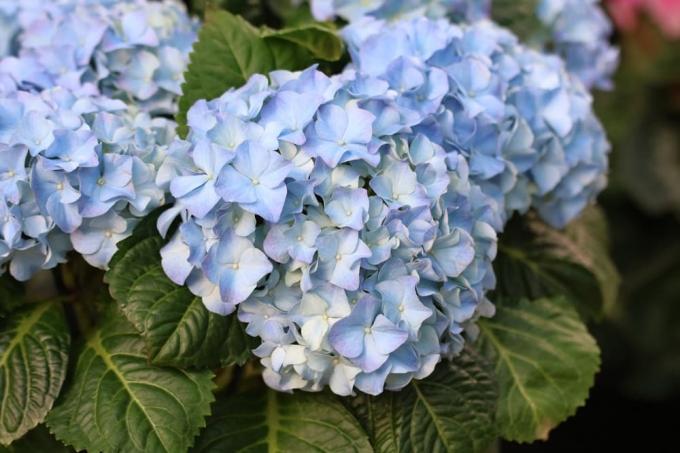

Table of contents
- Before the determination
- Arrange leaf position
- Identify leaf shape
- Note special sheet properties
- identify flowers
- classify fruits
- Winter purpose: branches and buds
- Procedure for coniferous shrubs
Identifying and recognizing shrubs is a skill that any hobby gardener can acquire. In order to be able to identify a species with certainty, various plant characteristics and conditions at the growing site must be examined. At first, the amount of information is still confusing. But with a little practice, the first successes are quickly apparent and determining becomes easier each time.
Before the determination
If you want to identify garden shrubs, most identification keys are not sufficient. Not only native species are planted in the garden. Many ornamental shrubs come from other countries and climate regions, which makes identification difficult. Approach this area slowly and try to recognize native bushes first. If you master the basic skills of identification and recognize basic shapes of leaves and flowers, you will find it easier to identify exotic plants. Do not give up too quickly, because the many relevant characteristics can cause confusion, especially at the beginning. Keep a notebook and get a first impression of these aspects:
- locality:Does the shrub grow in the forest, by water or in meadows?
- Blossom:Does the tree develop an inflorescence or single flowers?
- heyday:Does the shrub bloom in spring, summer or fall?
- Fruit:If any, what do they look like?
- Leaves:What shape does the foliage have and how are the leaves arranged on the branch?
- branches:Is the bark smooth or textured?
- Buds:What shape do they have and how do they grow on the branch?
Tip:
Also take properties like growth height and growth habit true and watch out for structures like thorns or spikes.
Arrange leaf position
Notice how the leaves sit on the branch. This so-called leaf position is a crucial feature and usually represents the first classification of the species. Trees are basically divided into two main groups. Your leaves are opposite or whorled when at least two leaves are at the same height on the branch opposite each other. Grape elder or common lilac belong to this group. The second main group are species whose leaves are alternate or tufted. In species such as raspberry, potato rose and sloe, the leaves emerge at different heights.
Identify leaf shape
There are numerous leaf forms that mix with each other and form intermediate forms. Try to recognize a rough shape in the sheet so that you can narrow it down or narrow it down. species can be excluded. Take notes on whether the leaf surface appears single or is incised into several sub-leaves. In botany, these partial leaves represent the pinnate leaves. If the leaves are not completely incised, botanists speak of fingered or sinuate leaves. The following leaf shapes are typical for simply designed leaves:
- ovate to elliptical: Bird cherry, Spindle bush, Red honeysuckle
- rounded to heart-shaped: Small-leaved and small-leaved lime, common hazel
- elongated to lanceolate: sea buckthorn, willows
- fingered or booked: Viburnum, hawthorn, grapevine

The fully pinnate leaves are a botanical peculiarity, because the supposedly numerous leaves are only one leaf. The number of leaflets varies depending on the species. Leaves are referred to as imparipinnate if they have a terminal partial leaf at the top. This includes most bushes and shrubs such as elderberry or vinegar tree. Pinnate leaves are symmetrical and do not develop a leaflet at the end.
A notice:
If you spot tiny little leaves at the base of the stem, don't be fooled. This leaf is not pinnate, but has stipules.
Note special sheet properties
Not only the shape is a relevant identifying feature, but also the hairiness, leaf margin and venation are species-specific. The edge of the leaf can be very different. In most shrubs, this is completely inconspicuous and appears smooth, which is why many species are difficult to separate. The range of species is limited as soon as the foliage is indented, toothed or sawn. Some plants pursue special survival strategies and protect themselves from predators with conspicuous structures. Other leaf shapes are an adaptation to certain living conditions. Take a close look at the leaf and look for clearly visible features:
- conspicuous leaf venation: Dogwood and cornel with upturned side veins
- prickly leaf edge: European holly develops leaves with sharp spines
- serrated to serrated leaf margin: Whitebeam, wild cherry
- downy hairy leaves: Woolly Viburnum, White Willow
identify flowers
When the garden shrubs are in bloom, identifying them is easy, even for beginners. Here, too, try to assign the flower to a specific basic shape. Each flower shape is typical of a particular family, which is why you can narrow down the species in question at a glance. Not all plant families harbor species that grow shrubby. Among the shrubs, lip-shaped, star-shaped or bell-shaped flowers are typical:
- radial or star-shaped: Common Hawthorn, Daphne, Buckthorn
- mirror symmetric: Honeysuckle, Red Honeysuckle
- bell-shaped to pitcher-shaped: Common cotoneaster, gooseberry, buckthorn

In some trees, numerous inconspicuous individual flowers crowd together in dense inflorescences, making it difficult to recognize the shape of the individual flowers. An example of unusual flower shapes are birches and willows. They develop inflorescences called catkins. These plants do not attach importance to attractive appearing petals, because they are pollinated by the wind or by insects.
Tip:
Use all your senses to determine, because smell and feel also provide information about the respective species.
classify fruits
There are different approaches to categorize fruits. The simplest variant is a rough subdivision according to the juice content. In contrast to nuts, berries and apples have a high juiciness. Some species do not develop a nutrient-rich or succulent feeding tissue, but send their seeds on their journeys with a simple protective coat. These special forms include a whole range of different fruit types:
- hairy fruits: Common clematis
- Nuts wrapped in overgrown leaves: hornbeam
- cone-like fruits: gall bush
- woody capsules: Common Lilac

For juicy fruits and nuts, look at the size and determine if they grow singly or in clusters on a stalk. These features often allow conclusions to be drawn about the original flower shape, so that you can also recognize shrubs without flowers. Berries can also be divided into color categories. A reliable determination with the usual keys is only possible if the fruits are in a ripe state. They go through different stages of maturity, in which they can change color several times.
Winter purpose: branches and buds
If you want to identify ornamental shrubs and bushes in winter, you must first look at the bush as a whole. Growth habit and branching are important characteristics. Also make a note of the height of the plants, because the species have adapted to different areas of life with their growth habit. Since these characteristics are not yet sufficient for a reliable identification of the species, you should use other characteristics. You can look at the bark on the branches. Since the structure and coloring of the branches varies with age, these aspects represent additional information. It is more important that you take a close look at the buds. These can be designed differently:
- Basic form: narrow, ovate to elongated, rounded, conical
- Color: light brown to whitish, dark brown to black, red to reddish brown, greenish
- End: pointed or rounded
- Position: alternate or opposite

Since identification based on the buds is not easy, a slow approach is recommended. Identify ornamental shrubs in summer based on their flowers and leaves. Then keep an eye on the identified trees and observe the changes. In winter, also look for old leaves and fruit on the ground, because you can clearly recognize the trees by them.
Procedure for coniferous shrubs
Conifers have developed completely different structures. Its leaves are greatly reduced and appear in the form of sharp needles. The flowers have no conspicuous petals because they are wind-pollinated. The fruits also differ from those of deciduous trees, as they are mostly cone-shaped and occasionally berry-shaped. However, the procedure for determining is similar. Most species can already be clearly identified on the basis of the needles. If leaf characteristics are not enough, turn your attention to flowers and fruit.
 garden editorial
garden editorial I write about everything that interests me in my garden.
Learn more about ornamental trees

Shell cypress, Chamaecyparis obtusa: 10 care tips
The clam cypress, which originated in Japan, is one of the most popular evergreen garden plants in this country. The 10 most important tips for caring for conifers have been compiled for you here.

Dwarf lilac: 9 tips for care and pruning
The dwarf lilac impresses with its magnificent and fragrant flowers, which at the same time form an ideal retreat for native insects. The nine most important tips for caring for and especially cutting mini lilacs are summarized here for you.

Flamingo Tree: Care and Pruning | flamingo pasture
The flamingo willow (Salix integra 'Hakuro Nishiki'), better known as the harlequin willow, is less noticeable with its inconspicuous flowers than with its colorful leaves. Its crown with the white-pink-green shoots draws everyone's attention, whether as a shrub or as a standard tree.

23 evergreen, hardy & fast growing shrubs
Evergreen and hardy shrubs are ideal for adding color to garden beds, patios and balconies in winter. Fast-growing specimens are particularly in demand. The 23 most popular shrubs can be found in the home garden guide.

The basics of hydrangea care
Hydrangeas provide a real bloom in the garden or on the balcony, as long as they are cared for professionally. Read here how best to do this.

Rhododendron location: 6 important criteria
Rhododendrons are known for their sea of flowers, which, depending on the variety, unfolds its full splendor between March and June. However, the plants only develop the numerous flowers if the location meets their requirements. Rhododendrons are extremely picky when it comes to location.
